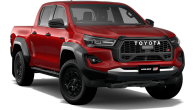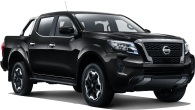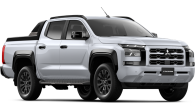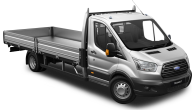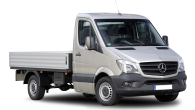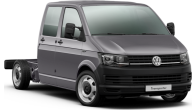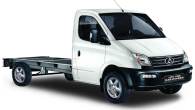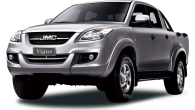There was a time when utes were bought purely for work but some these days look more like high-riding prestige cars with their sparkling pearlescent paint, sumptuous leather seats that heat, cool and massage, high-tech hybrid drivetrains, independent rear suspensions and 0-100km/h times that were once the sole domain of supercars.
However, traditional ute buyers like tradies, farmers and fleets are still well catered for by some brands when seeking a utilitarian turbo-diesel workhorse designed primarily for hard yakka.
Mitsubishi has recently added 4x2 and 4x4 cab-chassis variants to its local Triton line-up comprising single-cab, club-cab and dual-cab body style across most model grades to broaden the Triton’s appeal for either working roles or adventuring.
We recently spent a week aboard one of these new cab-chassis variants in base GLX specification, to see from a tradie’s perspective if it has what it takes to cut it in the rough-and-tough world of working utes.
Mitsubishi Triton 2026: GLX (4X4)
| Engine Type | Diesel Turbo 4, 2.4L |
|---|---|
| Fuel Type | Diesel |
| Fuel Efficiency | 7.6L/100km (combined) |
| Seating | 5 |
| Price From | $49,490 |
| Safety Rating |
|
Does it represent good value for the price? What features does it come with?
8 / 10
The Triton’s cab-chassis list pricing (without tray) starts at $34,490 for the GLX single-cab 4x2 manual and finishes at $61,540 for the premium GSR dual-cab 4x4 auto.
Our GLX test vehicle comes standard with a 2.4-litre twin-turbo four-cylinder diesel engine (shared by all Tritons) and optional six-speed automatic for $49,490. This pricing is competitive with base-model 4x4 dual-cab-chassis equivalents like the Toyota HiLux Workmate ($48,735), Ford Ranger XL ($49,230) and Isuzu D-Max SX ($51,200).
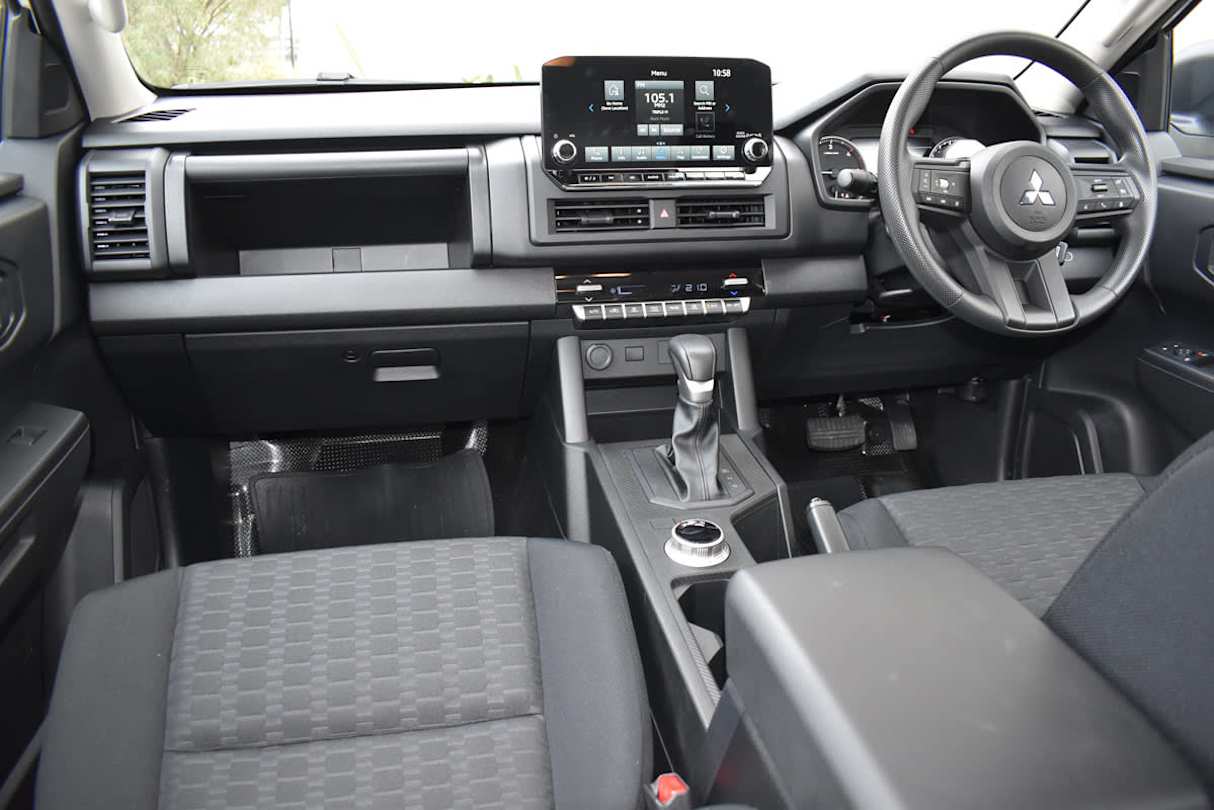
However, our example is loaded with numerous items from Mitsubishi’s genuine accessories range including a steel tray ($5775), rear ladder rack ($951.42), steel bull-bar ($4755), driving lights ($1295), side-steps ($1750) and 3500kg towing kit/electronic brake controller ($2370).
This desirable ensemble adds almost $17,000 to the price, which with on-road costs would be nudging $70K to drive away. So, buyers must keep their budgets in mind, as it’s easy to get carried away in genuine accessory lolly shops.
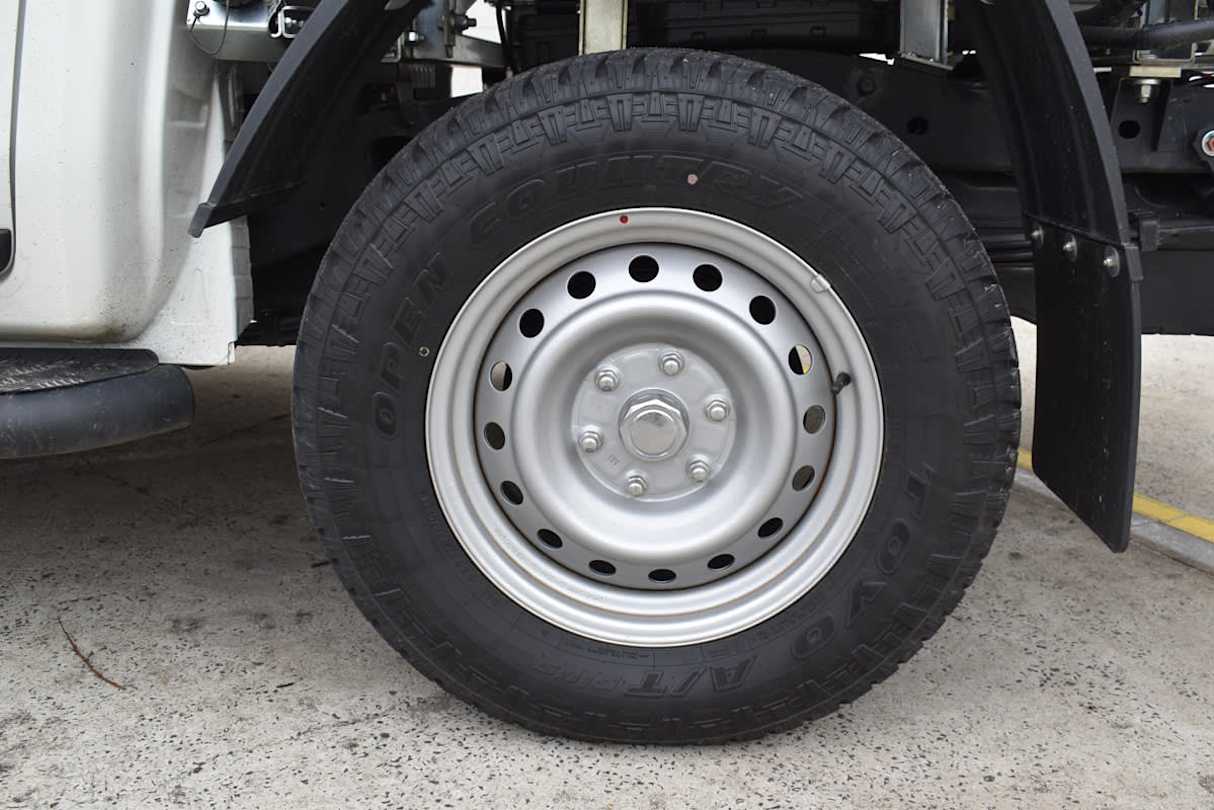
Our test vehicle comes standard with 17-inch steel wheels and 265/65R17 all-terrain tyres plus a full-size spare. It also has heavy-duty rear suspension and underbody armour, front/rear parking sensors, reversing camera, tyre-pressure monitoring and more.
The work-focused cabin has wipe-clean fabric seat trim and vinyl floors, power-adjustable driver’s lumbar support, twin 12-volt accessory sockets and USB ports, 7.0-inch driver’s instrument cluster and a four-speaker audio system controlled by a 9.0-inch multimedia screen with Android Auto, Apple CarPlay and Bluetooth connectivity.
Is there anything interesting about its design?
8 / 10
Our test vehicle rides on a compact 3130mm wheelbase and is 1865mm wide and 1795mm tall, which combined with a 12.4-metre turning circle makes it agile and easy to manoeuvre both on and off-road.
Speaking of which, its all-terrain credentials include 228mm of ground clearance, a useful 30.4 degrees approach angle (without bull-bar) and 23.4 degrees ramp breakover angle, with the departure angle dependent on the type of tray fitted. These numbers would be more than adequate for accessing rugged worksites.
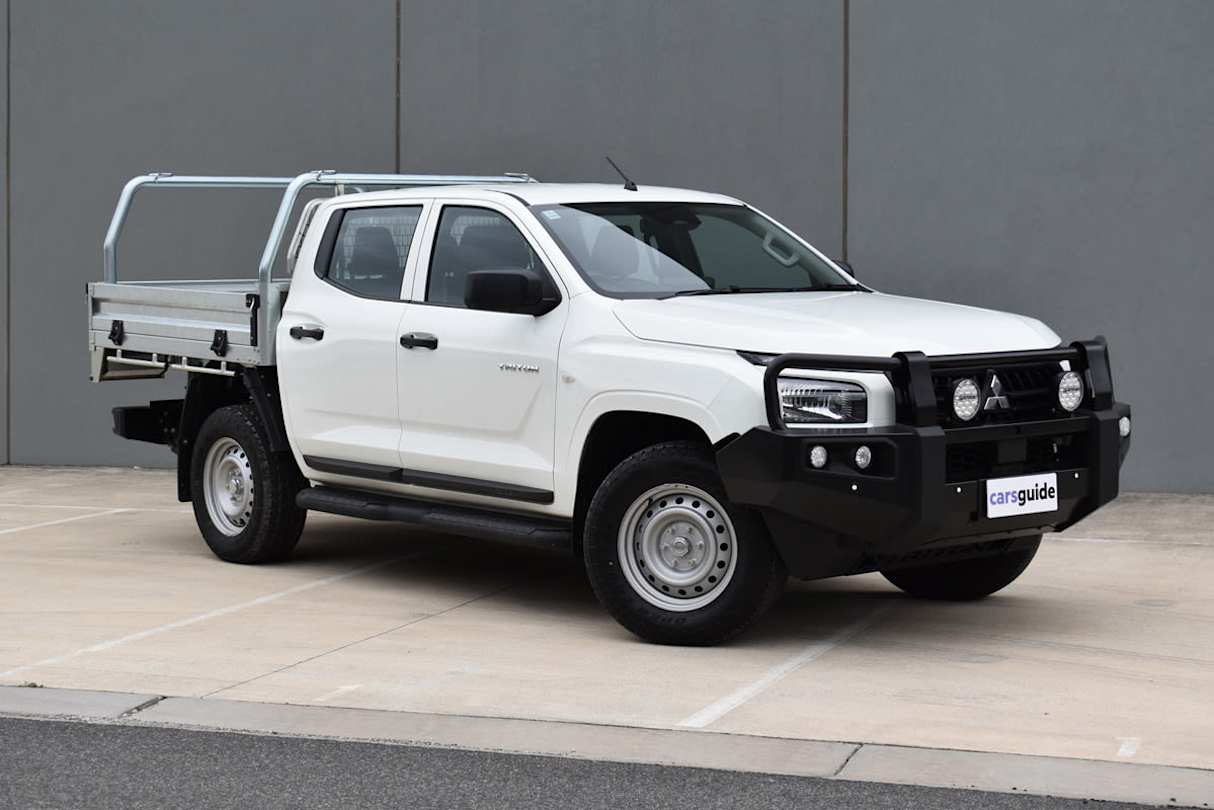
Its front suspension is double-wishbone with coil-springs, paired with a robust leaf-spring live rear axle. Brakes are front discs and rear drums and it has electric power-assistance for the rack and pinion steering.
Looks are subjective of course but we reckon it has a robust and purposeful appearance in cab-chassis form, particularly with the accessories fitted to our example.
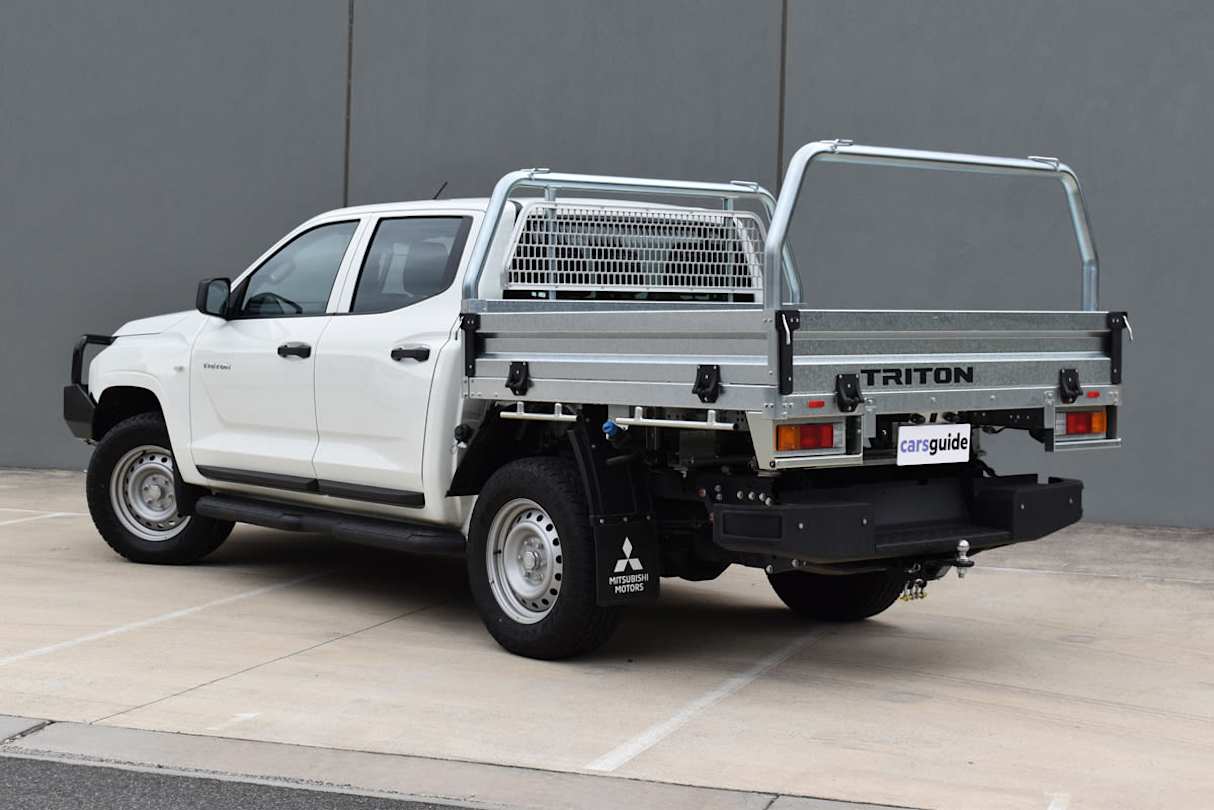
Chrome is all but extinct in its predominantly grey interior. However, hard surfaces on the centre console and door-pulls have a synthetic carbon-fibre finish, which adds a touch of style to a low-maintenance cabin that won’t get trashed by spilled coffee or muddy boots.
You also won’t find fancy features like digital instruments (it has analogue speedo/tacho) or an electronic handbrake (this one’s the good old manual lever). Plus there’s physical dials for audio volume/tuning and ‘piano key’ buttons for the cabin’s climate control, which ensures no distracting touchscreen prompts when driving.

How practical is its space and tech inside?
8 / 10
With a kerb weight of only 1993kg (without tray) and 3200kg GVM, our test vehicle has a 1207kg payload rating. However, after you add the combined weight of its steel tray and other accessories (417kg), the payload rating is reduced by the same amount to 790kg. Even so, that still leaves a sizeable weight capacity for up to five tradies and their tools.
It’s also rated to tow up to 3500kg of braked trailer but with its 6250kg GCM (or how much it can legally carry and tow at the same time) the payload would have to be reduced by 450kg (from 790kg to 340kg) to avoid exceeding the GCM.
In real-world use it’s unlikely that many (if any) Triton owners would need to tow 3500kg but it’s important to be across these numbers to avoid overloading, which is dangerous and illegal.
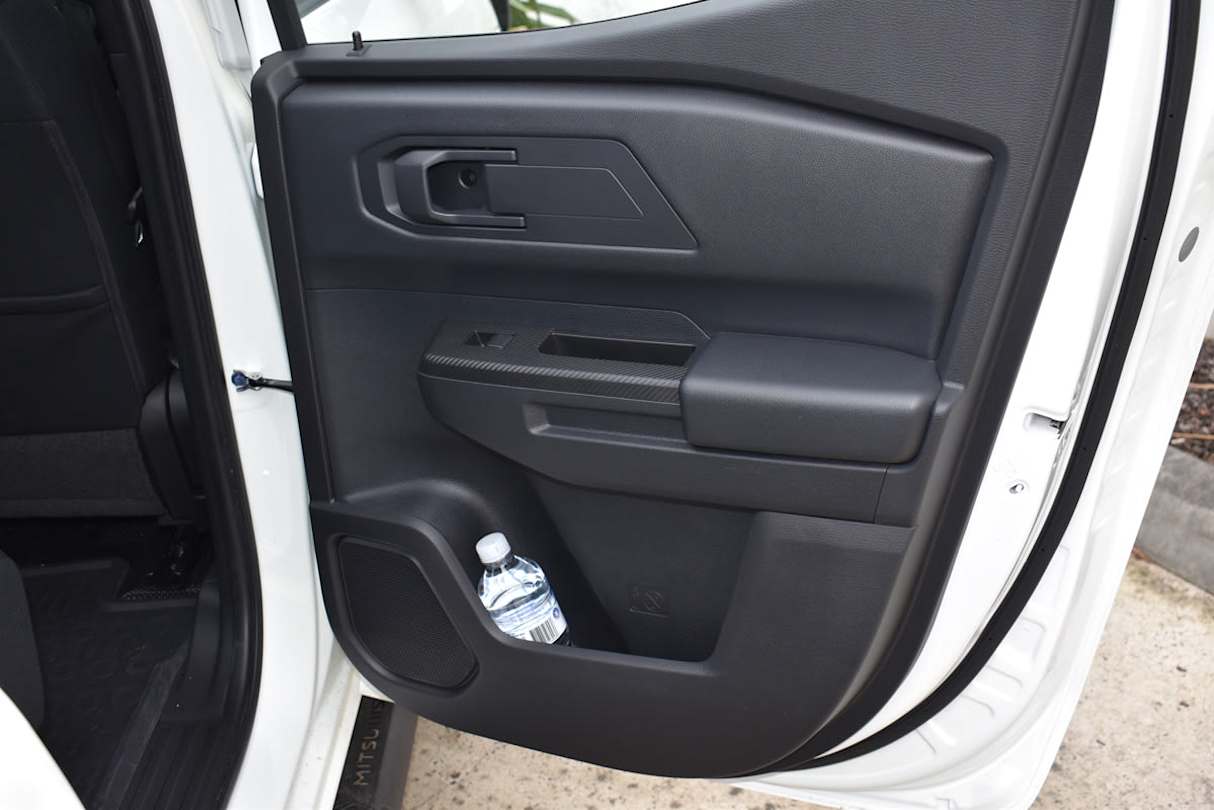
The genuine accessory galvanised steel tray is internally 1650mm long and 1780mm wide. It has a robust checker-plate floor and a tube-frame front bulkhead with sturdy wire-mesh rear window protection.
There’s also swing-up load retainers on top of the tube-frame on each side, which when paired with the matching rear tube-rack accessory provides secure carrying space for extension ladders or long lengths of timber and PVC pipe/conduit.
There’s also external rope/strap rails along each side but like all steel trays we’ve come across there’s no internal load-anchorage points.
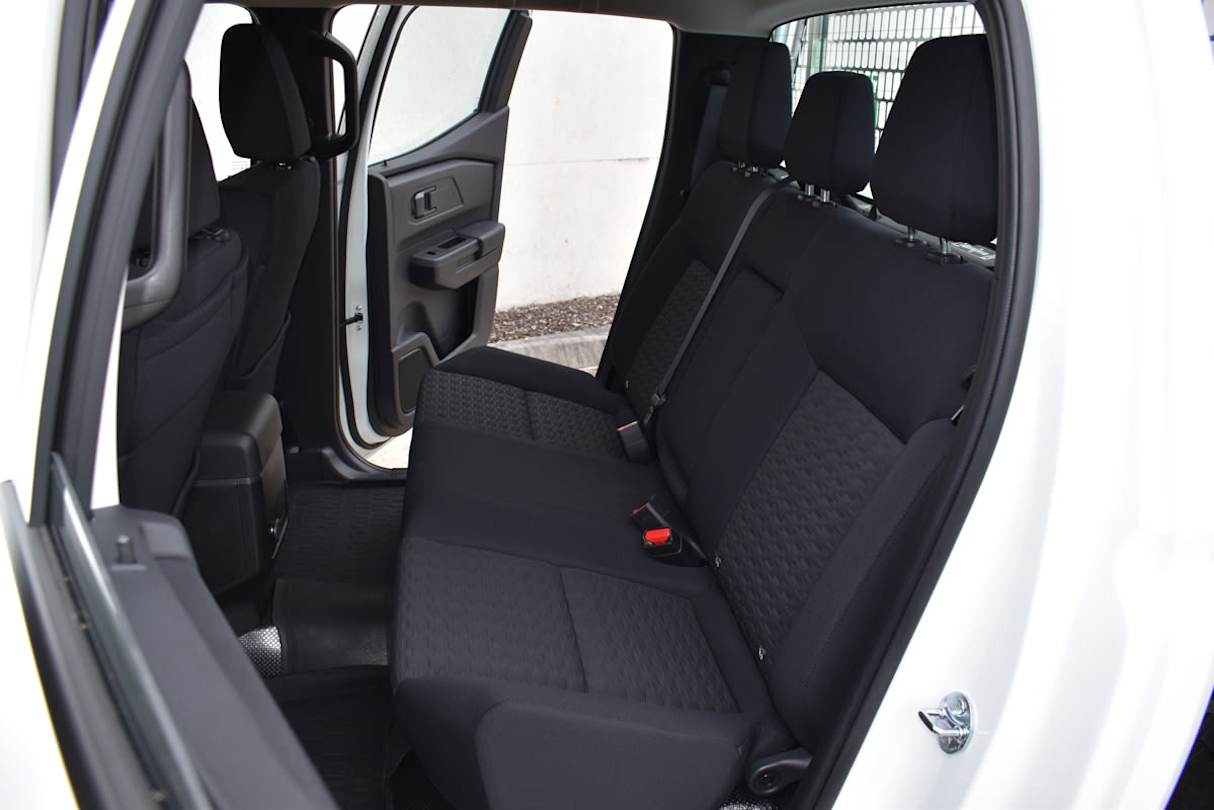
The driver and front passenger have access to a bottle holder and storage bin in each front door plus an overhead glasses holder and a large open compartment above the glovebox. The centre console offers more open storage plus two bottle/cupholders in the centre and a usefully-sized box at the back with a lid that doubles as a driver’s elbow rest.
The rear bench seat is comfortable and surprisingly spacious for tall people, given I’m 186cm and when seated behind the driver’s seat when set in my position, I have about 40mm of kneeroom and 60mm of headroom.
There’s also adequate head clearance for those seated in the slightly higher centre position, but the floor’s prominent transmission tunnel requires one boot either side and knees together between the front seat backrests.
And like all dual-cab utes short of a full-size US pick-up, rear shoulder room is squeezy for three adults, which is tolerable for short trips but a maximum of two adults would be ideal for longer drives.
Rear seat storage includes a bottle-holder and bin in each door plus pockets on each front seat backrest. The centre seat’s backrest also folds forward to serve as an armrest with dual bottle/cup-holders.
The bench seat’s base cushion is fixed, so unlike numerous rivals it can’t swing up and be stored vertically if more internal carrying space is required.
What are the key stats for its engine and transmission?
8 / 10
The Triton’s 2.4-litre four-cylinder diesel engine is equipped with two turbochargers that work in sequence to boost efficiency, with the smaller one providing fast response at low rpm and the larger one optimising performance at higher rpm. The result is 150kW of power at 3500rpm and torque peaking at 470Nm between 1500-2750rpm, using AdBlue to minimise emissions.
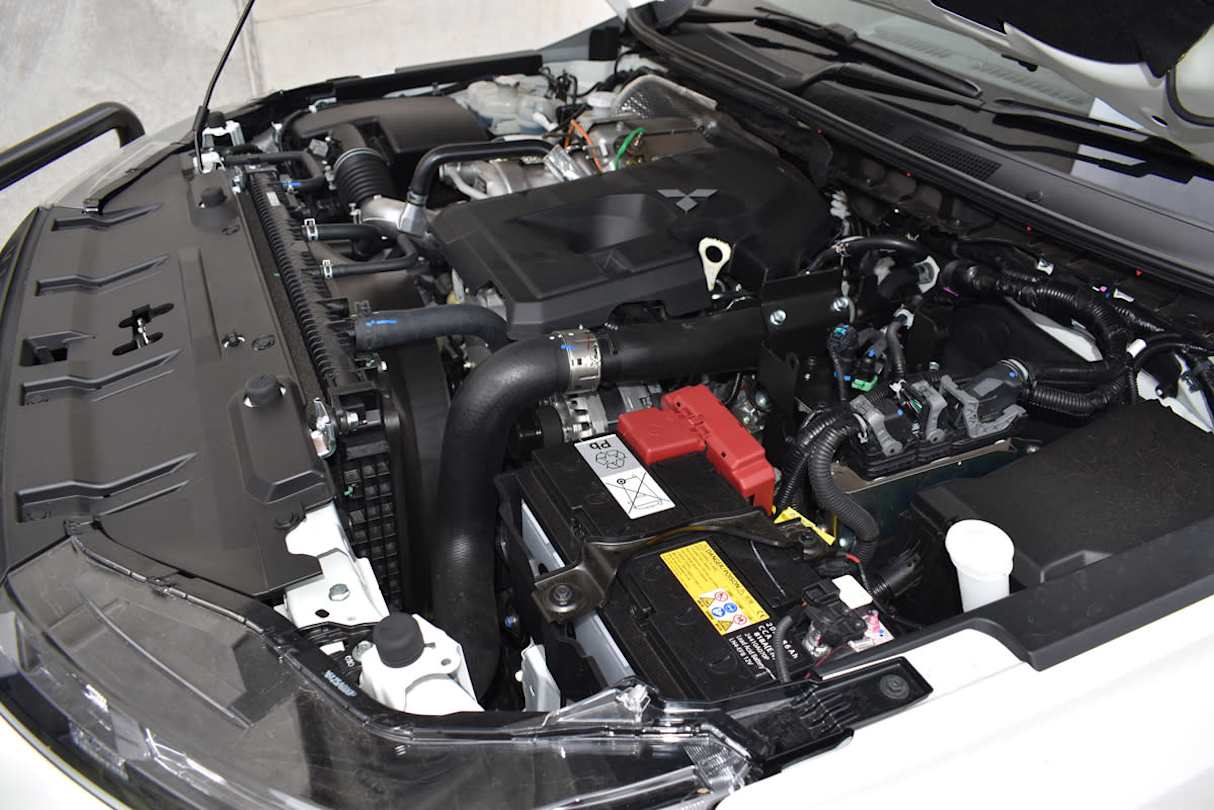
It’s paired with a six-speed torque converter automatic that offers the choice of sequential manual shifting, which can be preferable when hauling and/or towing heavy loads, particularly in hilly terrain.
The 4x4 system is dual-range, part-time offering 2H (2WD High Range), 4H (4WD High Range) and 4L (4WD Low Range) controlled by a dial on the centre console. However, you need to step up to the GLX+ to get a rear diff-lock.
What is its fuel consumption? What is its driving range?
8 / 10
Mitsubishi claims official combined average consumption of 7.7L/100km but the dash display was showing 9.9 at the completion of our 316km test, which included the usual mix of suburban, city and highway driving of which about one third of that distance was hauling its maximum payload.
Our own consumption figure, calculated from fuel bowser and tripmeter readings, came in higher again at 10.7L/100km which is on the borderline of the usual 2-3L/100km discrepancy between manufacturer claims and real-world consumption.
So, based on our own numbers, the test vehicle should have a real-world driving range of around 700km from its 75-litre tank.
What’s it like to drive?
8 / 10
Large assist-handles on the A (and B) pillars, combined with the accessory side-steps on our example, make it easy to climb aboard and find a comfortable driving position.
The unladen ride is firm, as you’d expect given its 6.0-tonne-plus GCM rating, but it’s still supple enough to soak up the bumps without the harsh kidney-belting ride suffered in some cab-chassis one-tonners we’ve tested.
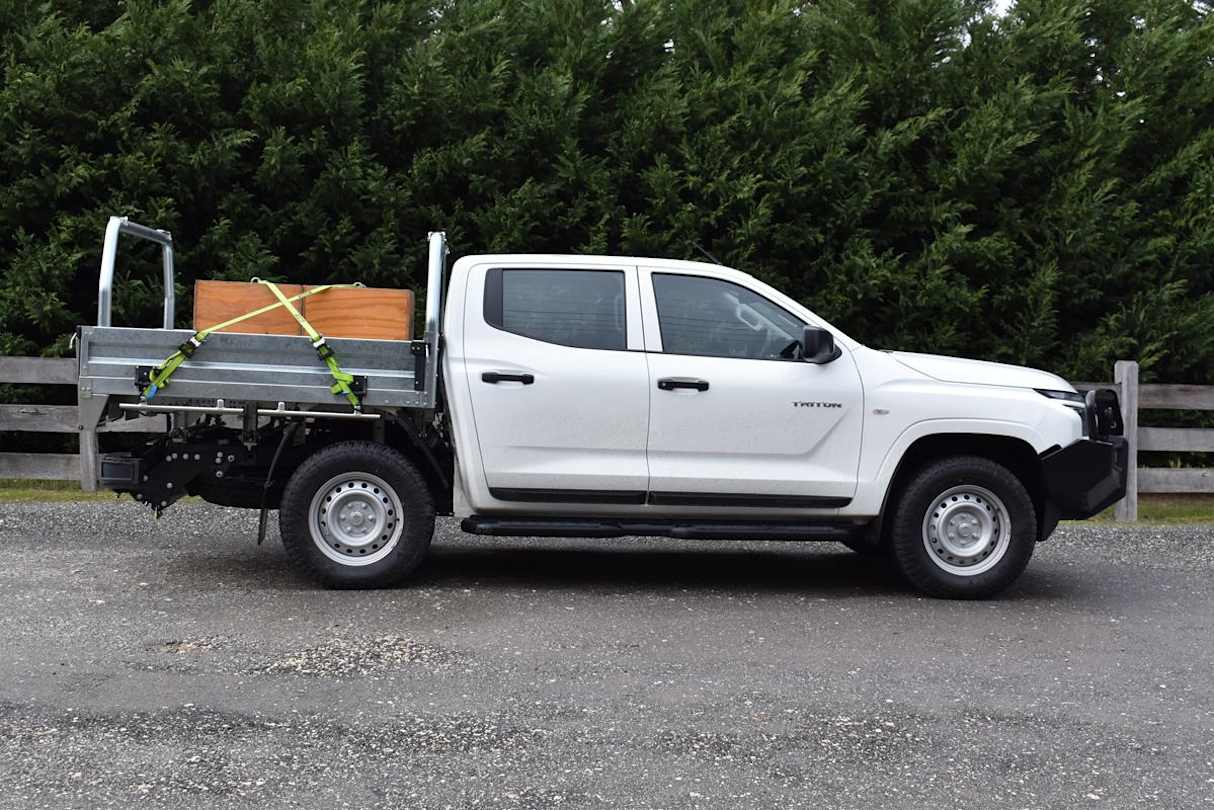
This is no doubt helped by the accessories fitted, which provide more than 400kg of additional sprung weight to engage the heavy-duty rear springs and improve the ride quality. That’s something to keep in mind if you often drive unladen.
The steering is firmly weighted and the brakes have good response, with the rear drums offering a terrier-like bite when the manual handbrake is applied on steep hills with a heavy load on board.
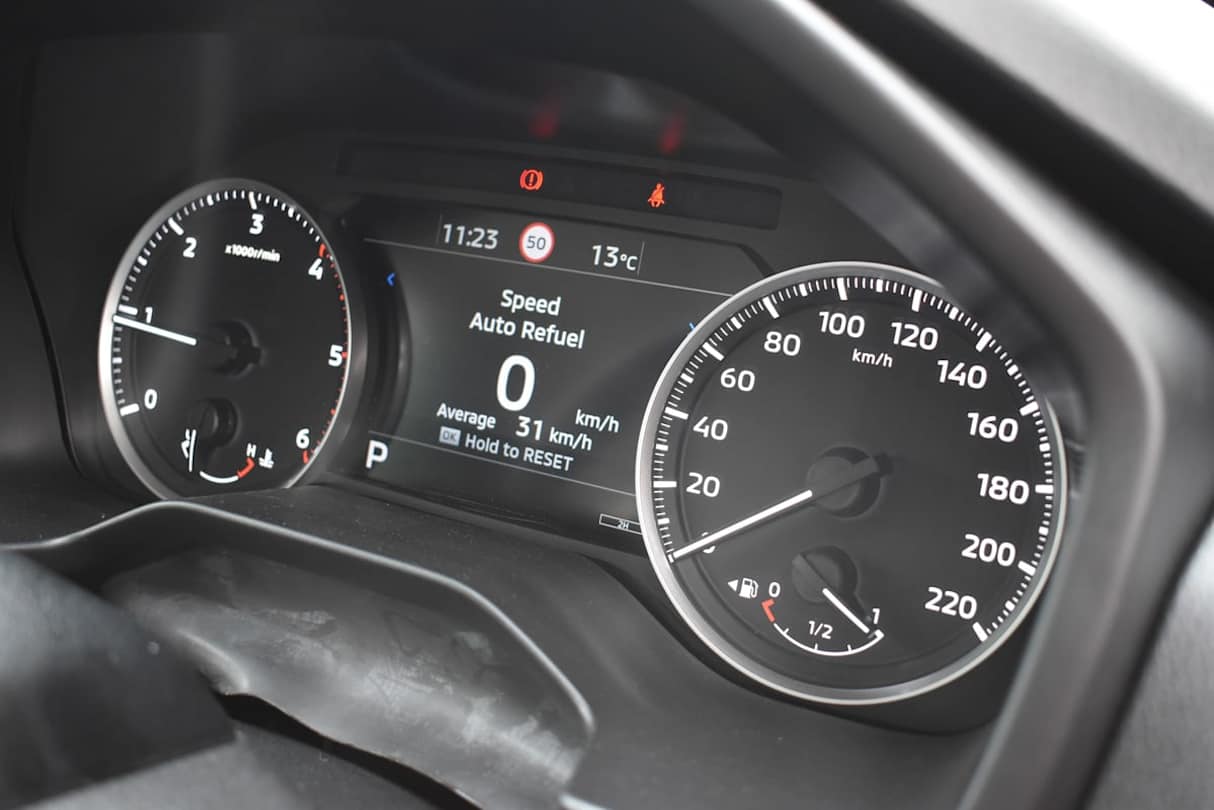
The four-cylinder 2.4-litre diesel, with its sequential turbocharging and strong outputs, provides energetic all-round performance with efficient gearing that ensures its operating within its peak torque band most of the time.
However, at highway speeds it does tend to hold top gear for too long, when the engine has dropped below 1500rpm and is clearly wanting a downshift.
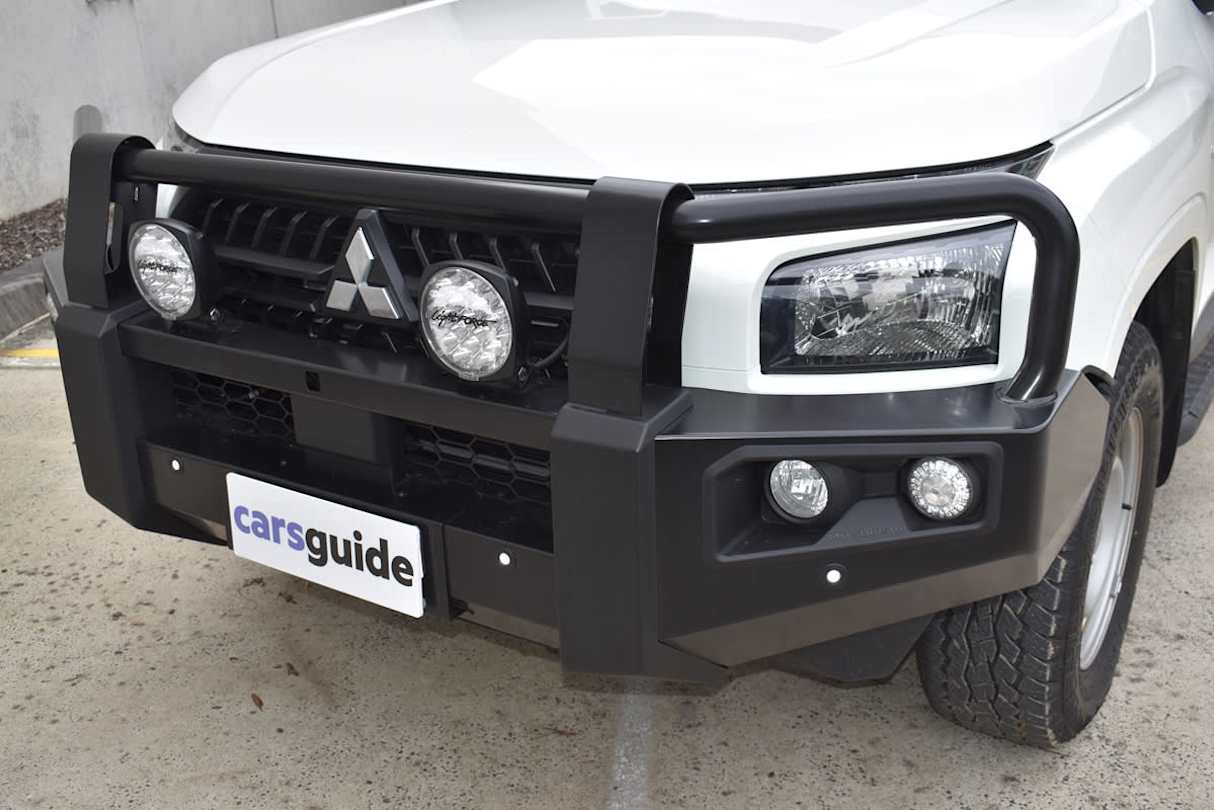
To test its payload rating, we strapped 650kg on the tray which when combined with accessories and crew was right on the weight limit. The stout rear springs compressed only 25mm under this load, leaving ample bump-stop clearance that assured there was no bottoming-out on our test route.
The Triton handled this task with competence, maintaining good performance and chassis stability. It easily hauled this load up our 13 per cent gradient, 2.0km set climb at 60km/h, with the six-speed auto self-shifting down to third gear and 2500rpm which was comfortably within its peak torque band. Engine braking on the way down was also commendable.
Our only gripe is the driver distraction monitoring system which is still too reactive in certain situations, like scratching an itch below my eye even though I was looking straight ahead while doing it. Even though Mitsubishi has tried to improve this system, it needs more refinement, as it detracts from an otherwise positive driving experience.
Warranty & Safety Rating
What safety equipment is fitted? What safety rating?
9 / 10
The Triton comes with a five-star ANCAP rating (tested 2024) and a suite of passive and active features highlighted by eight airbags (including side-curtains), auto emergency braking (AEB) with pedestrian/cyclist detection and junction assist, rear AEB when reversing, front/rear cross-traffic alert, traffic sign recognition, adaptive cruise control, lane-keeping, front/rear parking sensors, reversing camera, trailer stability assist and lots more. Rear seat has ISOFIX child-seat anchorages on the two outer rear seating positions and three top-tethers.
What warranty is offered? What are its service intervals? What are its running costs?
8 / 10
It comes with a five-year/100,000km standard warranty, or 10 years/200,000km if serviced at Mitsubishi dealers.
Scheduled servicing is every 12 months/15,000km whichever occurs first. Pricing is capped at $6860 for 10 scheduled services up to 10 years/150,000km, or an average of $686 per service.
Mitsubishi currently has more than 200 dealers across its national network that spans metro, rural and regional areas. Mitsubishi dealerships are also service centres.
Verdict
Apart from its distracting driver attention monitor, we can't see any major flaws that would detract from this vehicle’s comfort, practicality and performance when serving as either a utilitarian 4x4 workhorse or back-to-basics 4x4 dual cab for adventures off the beaten track.





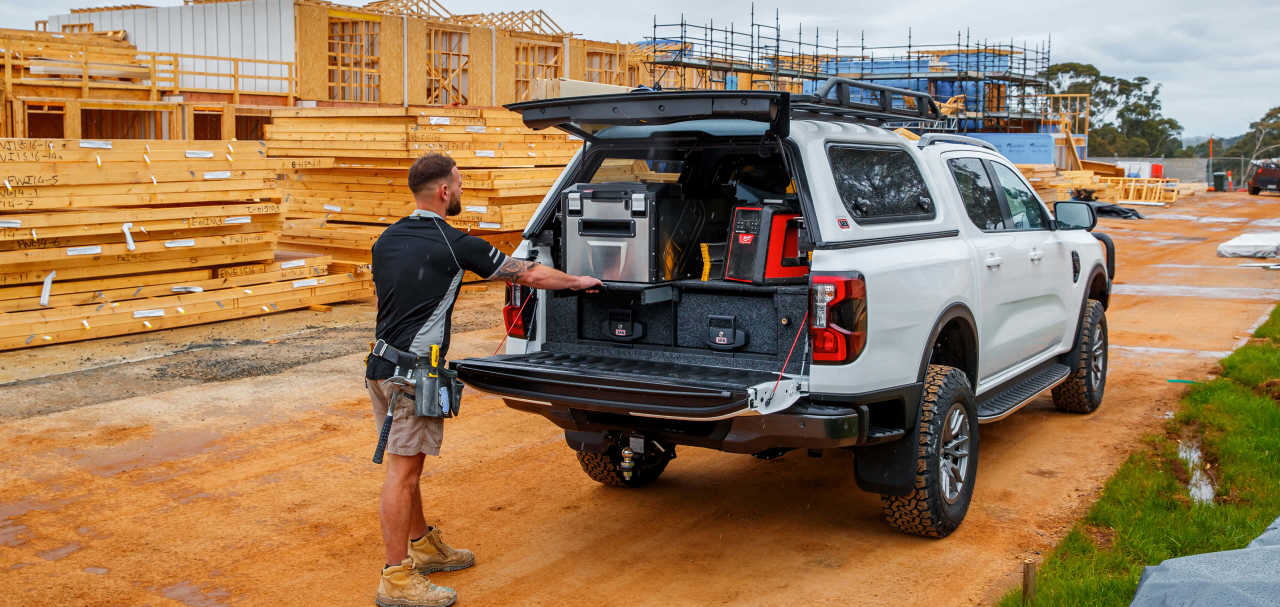

.jpg)






.jpg)


